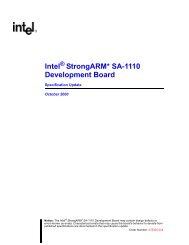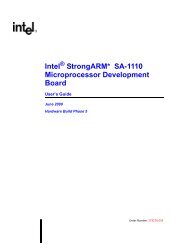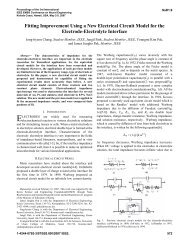Beej's Guide to Network Programming Using Internet Sockets
Beej's Guide to Network Programming Using Internet Sockets
Beej's Guide to Network Programming Using Internet Sockets
- No tags were found...
You also want an ePaper? Increase the reach of your titles
YUMPU automatically turns print PDFs into web optimized ePapers that Google loves.
Beej’s <strong>Guide</strong> <strong>to</strong> <strong>Network</strong> <strong>Programming</strong> <strong>Using</strong> <strong>Internet</strong> <strong>Sockets</strong> 5How do stream sockets achieve this high level of data transmission quality? They use apro<strong>to</strong>col called “The Transmission Control Pro<strong>to</strong>col”, otherwise known as “TCP” (see RFC-793 5for extremely detailed info on TCP.) TCP makes sure your data arrives sequentially and error-free.You may have heard “TCP” before as the better half of “TCP/IP” where “IP” stands for “<strong>Internet</strong>Pro<strong>to</strong>col” (see RFC-791 6 .) IP deals primarily with <strong>Internet</strong> routing and is not generally responsiblefor data integrity.Cool. What about Datagram sockets? Why are they called connectionless? What is the deal,here, anyway? Why are they unreliable? Well, here are some facts: if you send a datagram, it mayarrive. It may arrive out of order. If it arrives, the data within the packet will be error-free.Datagram sockets also use IP for routing, but they don’t use TCP; they use the “User DatagramPro<strong>to</strong>col”, or “UDP” (see RFC-768 7 .)Why are they connectionless? Well, basically, it’s because you don’t have <strong>to</strong> maintain anopen connection as you do with stream sockets. You just build a packet, slap an IP header on itwith destination information, and send it out. No connection needed. They are generally used forpacket-by-packet transfers of information. Sample applications: tftp, bootp, etc.“Enough!” you may scream. “How do these programs even work if datagrams might getlost?!” Well, my human friend, each has it’s own pro<strong>to</strong>col on <strong>to</strong>p of UDP. For example, the tftppro<strong>to</strong>col says that for each packet that gets sent, the recipient has <strong>to</strong> send back a packet that says, “Igot it!” (an “ACK” packet.) If the sender of the original packet gets no reply in, say, five seconds,he’ll re-transmit the packet until he finally gets an ACK. This acknowledgment procedure is veryimportant when implementing SOCK_DGRAM applications.2.2. Low level Nonsense and <strong>Network</strong> TheorySince I just mentioned layering of pro<strong>to</strong>cols, it’s time <strong>to</strong> talk about how networks really work,and <strong>to</strong> show some examples of how SOCK_DGRAM packets are built. Practically, you can probablyskip this section. It’s good background, however.Data Encapsulation.Hey, kids, it’s time <strong>to</strong> learn about Data Encapsulation! This is very very important. It’s soimportant that you might just learn about it if you take the networks course here at Chico State ;-).Basically, it says this: a packet is born, the packet is wrapped (“encapsulated”) in a header (andrarely a footer) by the first pro<strong>to</strong>col (say, the TFTP pro<strong>to</strong>col), then the whole thing (TFTP headerincluded) is encapsulated again by the next pro<strong>to</strong>col (say, UDP), then again by the next (IP), thenagain by the final pro<strong>to</strong>col on the hardware (physical) layer (say, Ethernet).When another computer receives the packet, the hardware strips the Ethernet header, the kernelstrips the IP and UDP headers, the TFTP program strips the TFTP header, and it finally has thedata.5 http://www.rfc-edi<strong>to</strong>r.org/rfc/rfc793.txt6 http://www.rfc-edi<strong>to</strong>r.org/rfc/rfc791.txt7 http://www.rfc-edi<strong>to</strong>r.org/rfc/rfc768.txt












